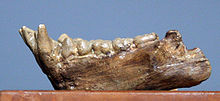| Pliopithecus Temporal range: Miocene,
| |
|---|---|

| |
| Mandible fragment of Pliopithecus antiquus from Sansan, France; cast from Museum national d'histoire naturelle, Paris | |
| Scientific classification | |
| Domain: | Eukaryota |
| Kingdom: | Animalia |
| Phylum: | Chordata |
| Class: | Mammalia |
| Order: | Primates |
| Suborder: | Haplorhini |
| Infraorder: | Simiiformes |
| Family: | †Pliopithecidae |
| Subfamily: | †Pliopithecinae |
| Genus: | †Pliopithecus Gervais, 1849 |
| Paleospecies | |
| |

Pliopithecus (meaning "more ape") is a genus of extinct primates of the Miocene. It was discovered in 1837 by Édouard Lartet (1801–1871) in France, with fossils subsequently discovered in Switzerland, Slovakia and Spain.
Pliopithecus had a similar size and form to modern gibbons, to which it may be related, although it is probably not a direct ancestor. It had long limbs, hands, and feet, and may have been able to brachiate, swinging between trees using its arms. Unlike gibbons, it had a short tail, and only partial stereoscopic vision.[1]
They appear to have originated in Asia and extended their range into Europe between 20 and 17 million years ago.[2]
Begun and Harrison list the following species within the genus:[2]
- Pliopithecus antiquus
- Pliopithecus bii
- Pliopithecus canmatensis
- Pliopithecus platyodon
- Pliopithecus vindobonensis
- Pliopithecus zhanxiangi
Pliopithecus antiquus has been referred to previously as P. piveteaui.[3] P. vindobonensis is sometimes considered to be a separate genus, Epipliopithecus.[4][2] Anapithecus is a close relative and was initially considered a subgenus of Pliopithecus.
- ^ Palmer, D., ed. (1999). The Marshall Illustrated Encyclopedia of Dinosaurs and Prehistoric Animals. London: Marshall Editions. p. 291. ISBN 1-84028-152-9.
- ^ a b c Harrison, Terry (2018). "Catarrhine Origins". In Trevathan, Wenda (ed.). The International Encyclopedia of Biological Anthropology. Vol. 1. John Wiley & Sons. pp. 306–311. doi:10.1002/9781118584538.ieba0087. ISBN 978-1-118-58442-2.
- ^ "Pliopithecus antiquus Blainville 1839".
Synonym: Pliopithecus piveteaui Hürzeler 1954
- ^ Harrison, T; Gu, Y (1999). "Taxonomy and phylogenetic relationships of early Miocene catarrhines from Sihong, China". Journal of Human Evolution. 37 (2): 225–277. Bibcode:1999JHumE..37..225H. doi:10.1006/jhev.1999.0310. PMID 10444352.